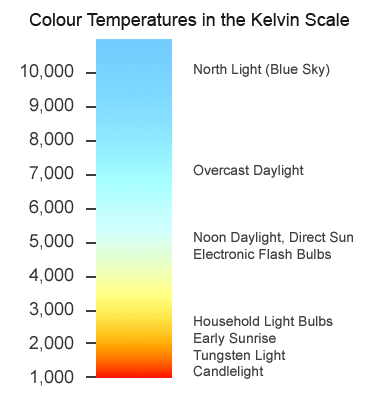Colour Temperature - Some Frequently Asked Questions
Posted by Richard Clarke on 27th Aug 2013

If you’re only just beginning to switch to LED as your Number One lighting source, you may have come across the term “Colour Temperature” for the first time. If this is the case, check out this list of FAQs, as it might help you choose the best one for you.
What Is Colour Temperature?
Colour temperature, or CCT (correlated colour temperature) as it’s also known, is a measurement in degrees Kelvin (K) of the perceived warmth or coolness of a light source.
Colour temperature is a characteristic of visible light that has important applications in lighting, but also in such disciplines as diverse as photography, videography and astrophysics.
How Is Colour Temperature Measured?
Light sources with different colour temperatures are assigned a Kelvin Rating (K), depending on how warm or cool they’re perceived to be.
These numbers can then be read against the Kelvin scale; similar to the way we read temperature.
However, unlike temperature, the Kelvin scale reads in the opposite direction. Thus, light sources with a high Kelvin Rating of 5000K or more will be perceived as cooler, while those with a lower Kelvin Rating of 4000K or less will appear warmer.
The easiest way to visualise this is to think about a Bunsen burner. When the flame is reduced, it becomes more yellowy-orange. Increase the flow of air to the flame and it becomes blue. The principle is the same with colour temperature, although there’s no actual temperature change involved.
What’s The Difference Between The Colour Temperatures?
Here at Wholesale LED Lights, we use the terms "Warm White" and "Cool White" to distinguish between light sources with a low and high colour temperature-rating respectively.
Our warm white has a Kelvin Rating of 3000K, while our cool white has a Kelvin rating of 6000K. In between the two is the Daylight colour temperature, which has a Kelvin Rating of 4000K.
Here’s a very basic chart, giving the approximate values in Kelvin of each different colour temperature:

Warm white is quite soft and mellow, with an orangey-yellow hue that’s similar to that of an old style incandescent light. Warm white bulbs are best suited to living spaces and rooms such as the bedroom, in which we traditionally relax and unwind.
Cool white on the other hand is a lot brighter and more penetrative form of light. Similar to that produced by a fluorescent tube light, it’s most often used in functional rooms such as the bathroom and the kitchen, in which work or task-related activities are carried out.
Daylight, as the name suggests, is the most naturalistic of the three colour temperatures, and is great for providing a bright yet convivial ambience that’s perfect both for communal areas and also for close work where an accurate perception of colour is required. Thus, it has begun to be adopted for people’s home offices and also for studios.
Which Colour Temperature Should I Choose For My Home?
Ask Yourself:
- Which type of room do I want to illuminate? Relaxation or work?
- What’s the reason for their use? General or feature lighting?
- What kind of ambience am I trying to create? Mellow or stark?
- Is this a traditional or a modern room? Convivial or minimalistic?
- How do I like this particular room or area to be lit? Personal choice.
By asking yourself these questions, you should go some way towards choosing the correct lighting for every category of home application.
We’ve also produced this short video to help you decide which colour temperature’s right for you:
However, if you’re still unsure, our customer service team is on hand to help you find the perfect LED light bulbs for your home. Just let them know what it is you hope to achieve, and they can recommend a colour temperature that’s ideal for you. Call today on 0116 321 4120, or send an e-mail enquiry to cs@wled.co.uk.





